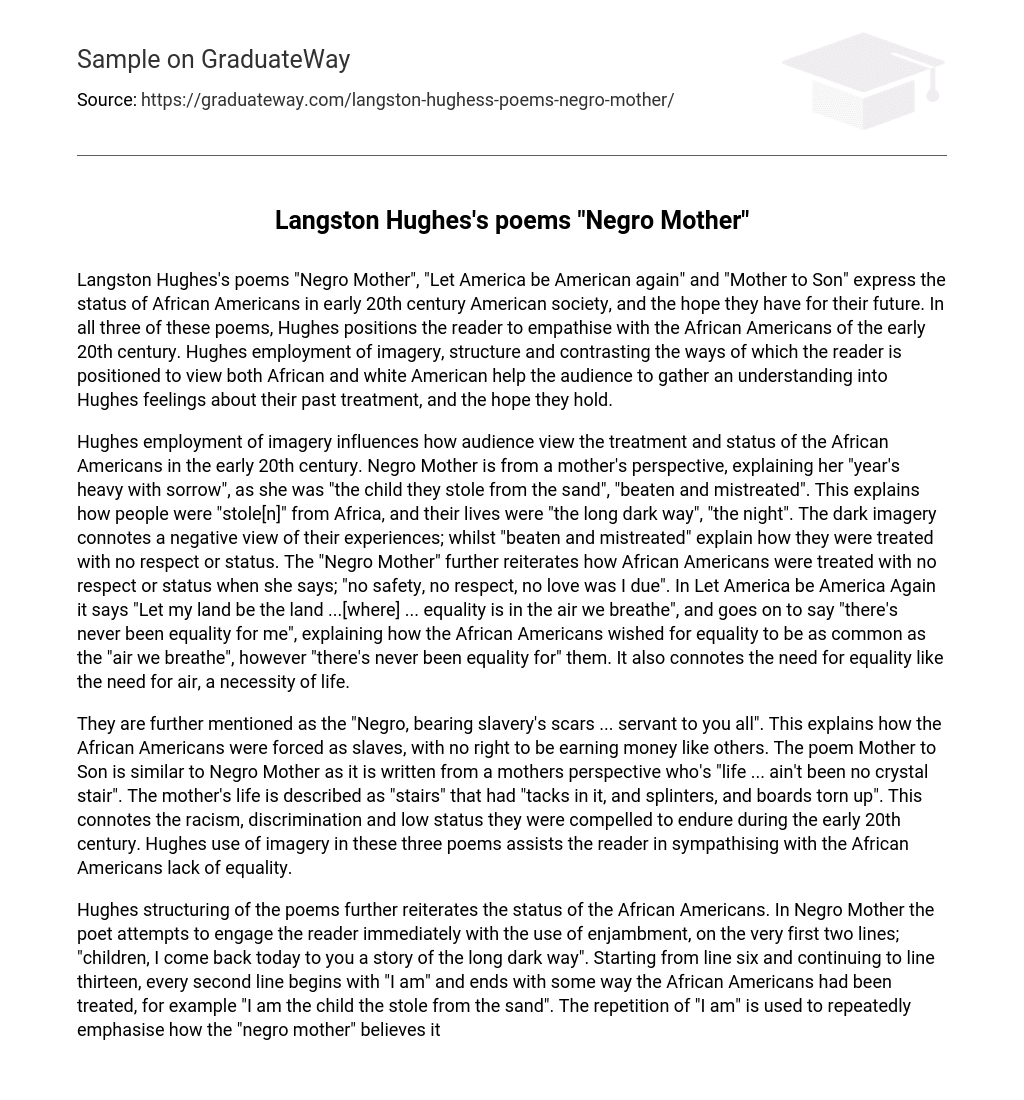Langston Hughes’s poems “Negro Mother”, “Let America be American again” and “Mother to Son” express the status of African Americans in early 20th century American society, and the hope they have for their future. In all three of these poems, Hughes positions the reader to empathise with the African Americans of the early 20th century. Hughes employment of imagery, structure and contrasting the ways of which the reader is positioned to view both African and white American help the audience to gather an understanding into Hughes feelings about their past treatment, and the hope they hold.
Hughes employment of imagery influences how audience view the treatment and status of the African Americans in the early 20th century. Negro Mother is from a mother’s perspective, explaining her “year’s heavy with sorrow”, as she was “the child they stole from the sand”, “beaten and mistreated”. This explains how people were “stole[n]” from Africa, and their lives were “the long dark way”, “the night”. The dark imagery connotes a negative view of their experiences; whilst “beaten and mistreated” explain how they were treated with no respect or status.
The “Negro Mother” further reiterates how African Americans were treated with no respect or status when she says; “no safety, no respect, no love was I due”. In Let America be America Again it says “Let my land be the land …[where] … equality is in the air we breathe”, and goes on to say “there’s never been equality for me”, explaining how the African Americans wished for equality to be as common as the “air we breathe”, however “there’s never been equality for” them. It also connotes the need for equality like the need for air, a necessity of life.
They are further mentioned as the “Negro, bearing slavery’s scars … servant to you all”. This explains how the African Americans were forced as slaves, with no right to be earning money like others. The poem Mother to Son is similar to Negro Mother as it is written from a mothers perspective who’s “life … ain’t been no crystal stair”. The mother’s life is described as “stairs” that had “tacks in it, and splinters, and boards torn up”. This connotes the racism, discrimination and low status they were compelled to endure during the early 20th century. Hughes use of imagery in these three poems assists the reader in sympathising with the African Americans lack of equality.
Hughes structuring of the poems further reiterates the status of the African Americans. In Negro Mother the poet attempts to engage the reader immediately with the use of enjambment, on the very first two lines; “children, I come back today to you a story of the long dark way”. Starting from line six and continuing to line thirteen, every second line begins with “I am” and ends with some way the African Americans had been treated, for example “I am the child the stole from the sand”.
The repetition of “I am” is used to repeatedly emphasise how the “negro mother” believes it was her, and her people, who had to face the discrimination and hardship of being degraded. Mother to Son also begins with a enjambment to engage the reader. In the poem there are two groups of three sentences which all begin with “and”.
These sentences all describe and list, metaphorically, how the African Americans had to overcome several obstacles. Let America be America’s is written in stanza’s and also features many examples of repetition. In most stanza’s, most of the sentences begin with the same word; for example stanza one with “Let” and stanza 4 with “I am”. The use of repetition reiterates the discrimination they faced, and the status they possessed.
For example in the fourth stanza, most of the sentences begin with “I am” and lists “I am the poor, white, folded, pushed apart, I am the Negro bearing slavery scars …”etc. The way in which Hughes structures the poems, particularly the use of repetition, gives the reader a further understanding into how the discrimination determine the status of the African Americans.





